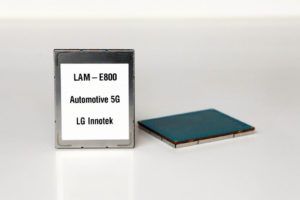South Korean electronics developer LG Innotek is the first company to develop a 5G cellular communication module for automotive applications using Qualcomm chips that can be installed in or on vehicles for V2X (Vehicle-to-Everything) data exchanges.
Based on the 5th-Generation Qualcomm chip, the new automotive module is a component that uses 5G mobile telecommunications technology to enable transmission of data between a vehicle and a cellular base station and wireless network connection. The module combines a communication chip, memory, and RF (radio frequency) circuit and is generally mounted on the inside of a vehicle or in a vehicle communication device on the roof. The module allows the sharing of real-time traffic information, precise location measurement, V2X communication, and transmission of larger amounts of data, providing the key functions that are needed for entirely autonomous driving that requires no involvement from the driver.
Recently, other companies have also focused on development of 5G communication modules, which are a key component of autonomous vehicles (AVs). In particular, companies have been in a fierce competition to successfully develop a module that runs on the Qualcomm Snapdragon Automotive 5G Platform. However, using 5G technology for communication modules for automotive deployment was not easy because it uses high frequency bands, causing higher loss of signals than LTE (Long Term Evolution, 4G mobile telecommunication technology), as well as high heat generation due to transmission of larger amounts of data. To solve this problem, LG Innotek used its proprietary RF circuit design technology, high precision and density modularized technology, as well as heat resistant new materials.
 The company’s new 5G communication module has a low latency (1ms or less), which is one tenth of that of an LTE module. This is why 5G technologies come into the spotlight in AV applications, because it requires more immediate response to changes in real-time situations. For example, if an AV driving at 62mph (100km/h) detects an obstacle and activates the urgent braking function, braking starts after the vehicle moves 4.5 feet (1.4m) with an LTE module, but with a 5G module, braking starts after the vehicle moves 1.1 inches (2.8cm) because the latency is lower.
The company’s new 5G communication module has a low latency (1ms or less), which is one tenth of that of an LTE module. This is why 5G technologies come into the spotlight in AV applications, because it requires more immediate response to changes in real-time situations. For example, if an AV driving at 62mph (100km/h) detects an obstacle and activates the urgent braking function, braking starts after the vehicle moves 4.5 feet (1.4m) with an LTE module, but with a 5G module, braking starts after the vehicle moves 1.1 inches (2.8cm) because the latency is lower.
LG Innotek’s 5G communication module for vehicles is small and slim, having an overall size of half a credit card (W40 x L50 x D3.5mm), packs about 480 components including communication chip, memory, RF circuit, and Cellular-V2X into the unit. Because it is compatible with LTE modules, the user only has to replace the LTE unit with the 5G module in the same spot without changing the system design.
It also comes with software optimized for the module and can be used regardless of the region or vehicle type because it follows the newest 5G standard; Release 15 from the 3rd Generation Partnership Project (3GPP).
“The successful development of 5G communication module for vehicles will speed up the commercialization of entirely autonomous vehicles and connected cars by manufacturers,” said an LG Innotek official. “We will continue to introduce innovative products that can provide drivers with safe, convenient, and enjoyable driving experience.”





